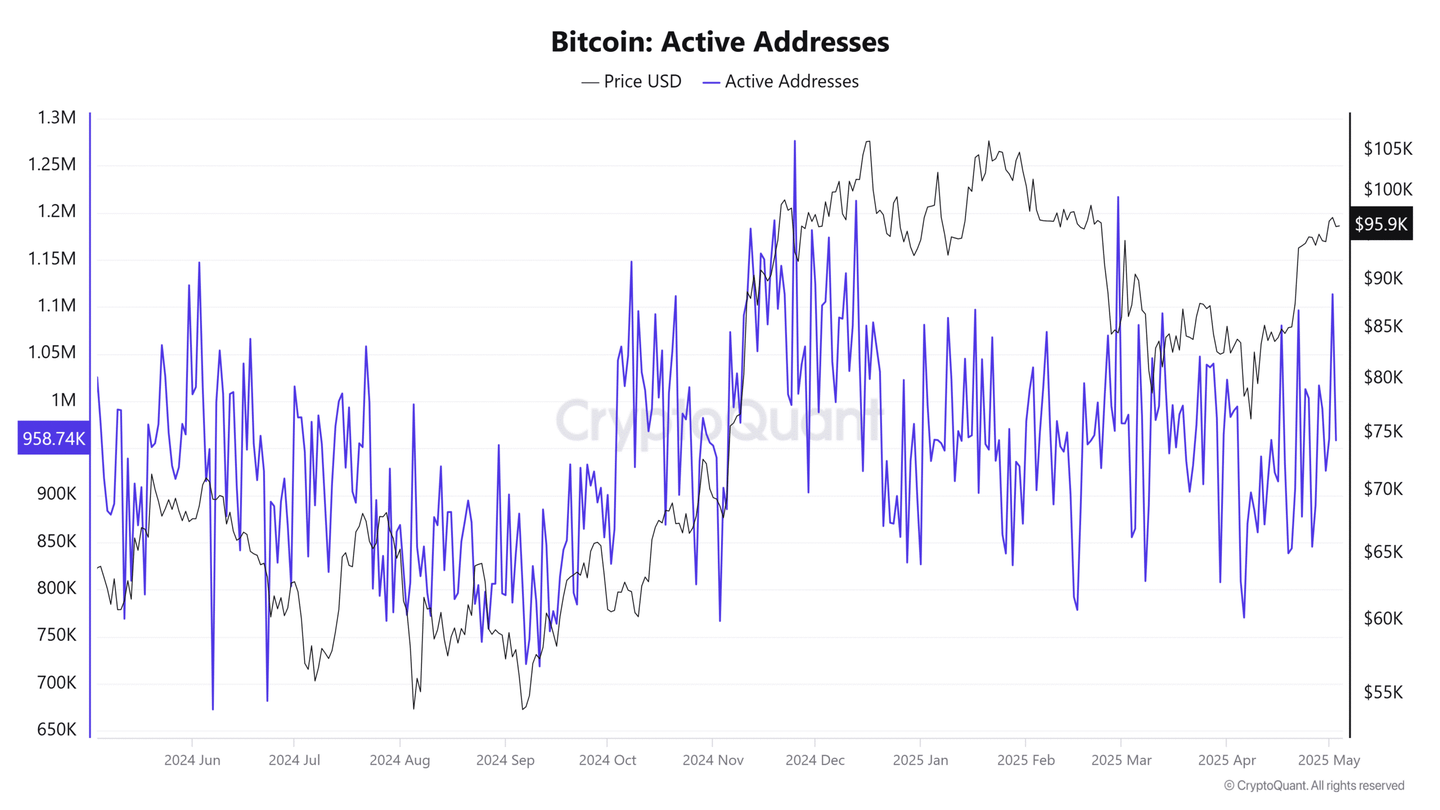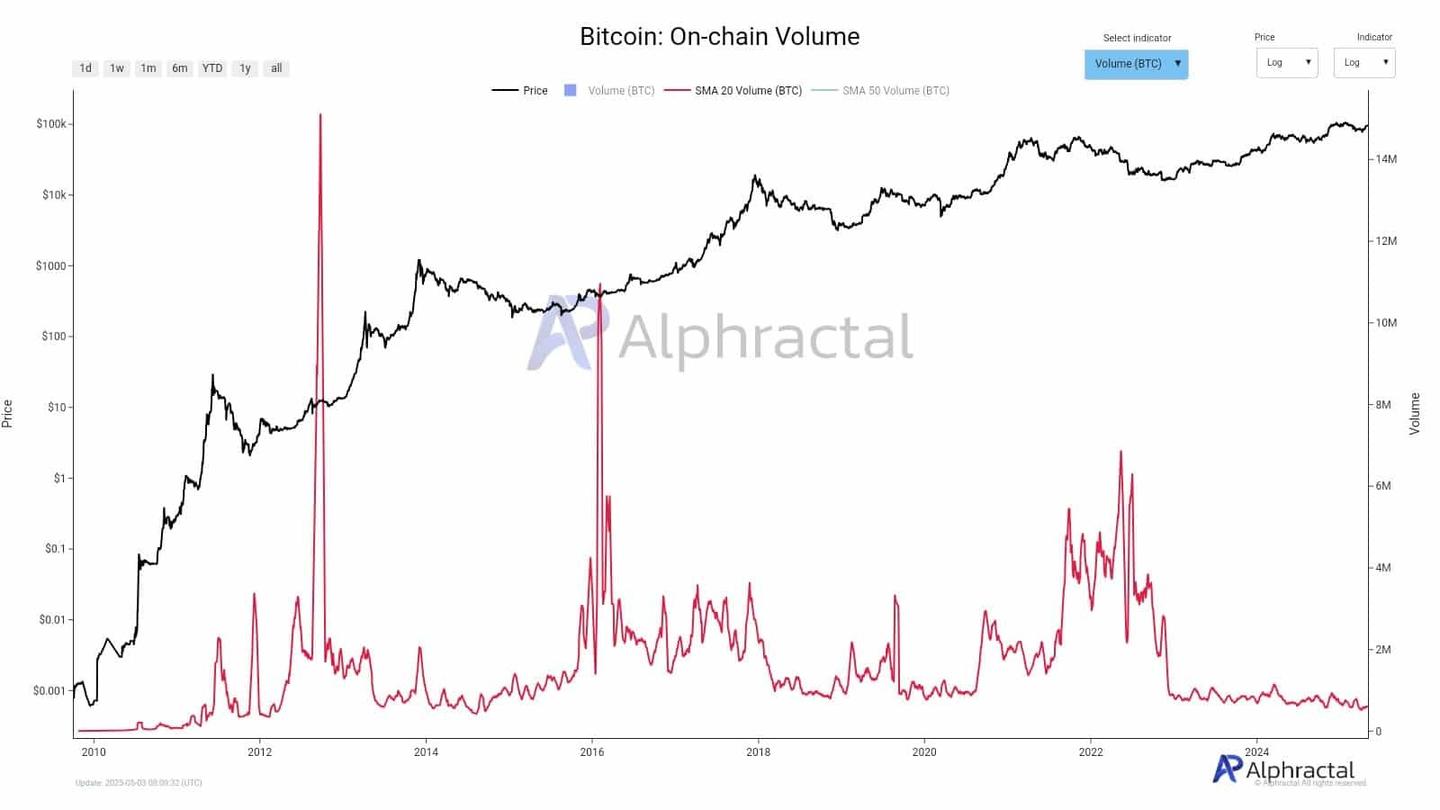Despite Bitcoin's recent price highs, reaching $97,000 in recent months, its network shows no corresponding signs of excitement. On-chain activity remains low, with key indicators such as active addresses and transaction numbers failing to reflect market enthusiasm.
VX: TZ7971
Notably, the number of active addresses has struggled to maintain the 1,000 threshold, breaking through only three times in the past few months—a signal worth considering for investors.

As of the time of writing, the number of active Bitcoin addresses hovers around 958,740—a relatively moderate figure considering the recent scale and momentum of the rise. This raises the question: Why is the network "defying" market value?
6 Reasons for Bitcoin's Stagnant On-Chain Activity
First, the current Bitcoin price is largely driven by external factors rather than actual blockchain usage demand. The market is influenced by institutional funds and spot ETF surges, not by actual user participation in the network. Large companies like Strategy, Metaplanet, and BlackRock continue to accumulate through these financial products, creating price momentum, but on-chain activity has not increased correspondingly.
Second, Bitcoin's price volatility is unusually low. After weeks of narrow trading between $92,000 and $95,000, the current price trend lacks a strong enough breakthrough to trigger active trading or wallet transfers.
In this context, many investors choose to wait and see, leading to a significant drop in on-chain transaction volumes.
Third, the market is experiencing a volume "inflation" phenomenon. Some recorded volumes may not accurately reflect the network's actual activity, leading to a misperception of the ecosystem's health. This "inflated" trading volume creates an illusion of excitement, while blockchain usage remains quite moderate.

Fourth, real-world usage has shifted to other blockchains. Platforms like Ethereum, Solana, and Base are attracting increasing DeFi activity, staking, and meme coin speculation. This has led to a clear trend: users are seeking ecosystems with richer features and higher traffic to perform on-chain activities.
For example, the Solana chain has become dominant in meme coins, while Ethereum still leads in staking. As usage shifts to other chains, Bitcoin becomes increasingly stagnant.
Fifth, Bitcoin's role as a practical payment system is weakening. The initial appeal of Bitcoin as a peer-to-peer transaction medium is slowly giving way to more flexible and faster platforms. The imbalance, with usage not keeping pace with price increases, raises market concerns about the sustainability of the upward trend. In the long term, if price does not reflect actual demand, the market may need to adjust.
Sixth, the rapid development of Layer 2 (L2) solutions like the Lightning Network also helps to "offload" the mainnet. As more transactions move to L2 networks with faster processing speeds and lower fees, mainnet activity appears to have slowed. While this is a positive technical advancement, it also means traditional on-chain indicators no longer fully reflect the network's health.
In short, Bitcoin's continued price rise does not necessarily mean increased blockchain usage. We are witnessing a clear shift: Bitcoin is increasingly viewed as a reserve asset, while other blockchains are where the real action in the crypto ecosystem occurs.
What This Means for BTC
Ultimately, price does not tell the whole story. Although Bitcoin shows impressive strength on price charts, this does not mean network activity is growing correspondingly. In fact, BTC's outstanding performance is occurring amid relatively low on-chain indicators—a notable paradox.
This indicates a clear shift in market perception of Bitcoin: from a decentralized currency for daily transactions to a macro financial asset for value storage.
Traditionally, Bitcoin's sustained growth was closely tied to the expansion of its user base, especially in the retail sector. This approach formed the basis of past strong bull market cycles.
However, cash flow now primarily comes from large financial institutions, with retail investors relatively absent, potentially making growth dynamics more fragile. If on-chain activity cannot recover, BTC price will face structural limitations, as market value is no longer supported by real-world usage.





